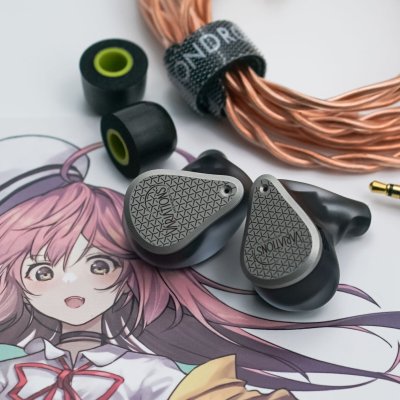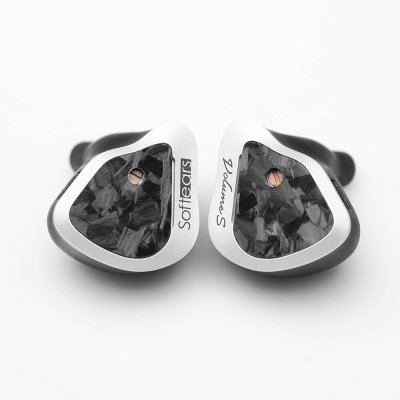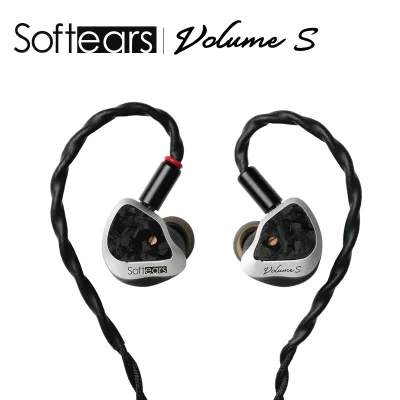Moondrop Variations and Softears Volume S use 1DD+2BA+2EST and 2DD+2BA driver setups respectively. Moondrop Variations costs $550 while Softears Volume S costs $320. Moondrop Variations is $230 more expensive. Softears Volume S holds a slight 0.2-point edge in reviewer scores (7.5 vs 7.7). User ratings place Moondrop Variations at 7.5 and Softears Volume S at 8.2. Softears Volume S has better bass with a 0.7-point edge, Softears Volume S has better mids with a 0.5-point edge, Moondrop Variations has slightly better soundstage with a 0.4-point edge, Moondrop Variations has better details with a 0.6-point edge and Moondrop Variations has better imaging with a 0.5-point edge.
Insights
| Metric | Moondrop Variations | Softears Volume S |
|---|---|---|
| Bass | 7.3 | 8 |
| Mids | 7.1 | 7.6 |
| Treble | 7.5 | 7.3 |
| Details | 7.3 | 6.7 |
| Soundstage | 7.8 | 7.4 |
| Imaging | 7 | 6.5 |
| Dynamics | 6.2 | 6.4 |
| Tonality | 7.4 | 7.8 |
| Technicalities | 7.6 | 7.4 |
Moondrop Variations Aggregated Review Score
Average Reviewer Scores
Average Reviewer Score:
7.5Generally Favorable
Softears Volume S Aggregated Review Score
Average Reviewer Scores
Average Reviewer Score:
7.7Strongly Favorable
Reviews Comparison
Moondrop Variations reviewed by Super* Review
Youtube Video Summary
Moondrop Variations enters the $520 bracket as a sleek tribrid (DD bass, BA mids, dual EST treble) that mirrors the Blessing 2 shell and fit—complete with the familiar large nozzle—while upgrading the look with a smoky, beach-glass finish. The package is generous (tips, foams, spare filters, and a modular cable with 3.5/4.4/2.5 swaps), though the case is bulky and the connector mechanism isn’t the slickest. Ergonomics are essentially the same as Blessing 2/Dusk; secure once sealed, but best with smaller tips.
Sonically, this reads as a refined “Dusk-plus”: a flatter lower-mid profile, prominent yet tidy sub-bass, and treble that’s a touch smoother and better extended than Blessing 2/Dusk. Despite measuring with more sub-bass than Dusk, it often feels less bassy in practice—more integrated, less showy—while preserving the line’s standout midrange detail and vocal clarity. Versus peers, staging depth benefits from the sub-bass lift (a hair more “space” than Blessing 2), and detail/resolution is effectively on par with Dusk; Blessing 2 still edges it for midrange naturalness, and all-BA sets like S8 retain the treble finesse crown.
The catch is value: performance moves forward, but only by small, picky margins. With Blessing 2/Dusk sitting a full $200 lower, Variations feels like a tasteful refinement rather than a categorical leap. For listeners who want a neutral core with an articulate sub-bass emphasis and slightly more air/polish up top than the Blessings—without the Dusk’s heavier bass feel—it’s an excellent pick. As scored, it earns 4 stars: easy to recommend on its tuning and competence, just shy of “must-buy” given how close its cheaper siblings perform.
Super* Review original ranking
Super* Review Youtube ChannelBuy Moondrop Variations on HiFiGO
Ad
Price: $479
Buy Moondrop Variations on HiFiGO
Softears Volume S reviewed by Super* Review
Youtube Video Summary
The Softears Volume S at $320 sets a new tonal benchmark for IEMs in its price range. It arrives in solid packaging featuring a zippered carry case (a bit large but functional), protective earpiece pockets that might feel overkill for some, and two excellent sets of ear tips – including Softears' own highly-regarded Ultra Clear tips. Build quality is generally fantastic, highlighted by a resin shell, a comfortable paracord-style cable with a low-profile, user-swappable termination system, and recessed 2-pin connectors. While the aesthetics might feel a bit old-school to some, the fit is comfortable and stable due to its semi-custom shape and longer nozzle, making it secure enough for sleeping. A small screwdriver-adjustable tuning switch offers a secondary, brighter Harmon-like sound signature, though the default tuning is preferred.
The default sound signature is a warm-tilted neutral, delivering exceptional natural timbre and tasteful bass boost. This bass stands out for its exceptional physicality – punchy and impactful without being overbearing – alongside articulate sub-bass that’s easy to follow. Combined with well-defined transients, particularly in the upper-midrange, it creates a satisfyingly rich and dense presentation. While spatial effects and imaging are competent but not standout, the overall tonality and bass quality are remarkably refined. Comparisons show it offers a better tonal balance and bass control than the bassier Dunu DaVinci, significantly more body and richness than the brighter, thinner Moondrop Blessing 3, and trades blows with the Moondrop Dusk – the Volume S providing superior density and mid-bass presence versus the Dusk's more open, spacious presentation.
Ultimately, the Softears Volume S earns a full five-star rating. It might not be the absolute most technically dazzling IEM, but its fantastic tonal balance, unique bass physicality, and overall refinement make it a compelling choice. For $320, it delivers a sound signature that feels just right – rich, satisfying, and universally appealing – challenging more expensive offerings and establishing itself as a top contender in its class.
Super* Review original ranking
Super* Review Youtube ChannelBuy Softears Volume S on HiFiGO
Ad
Price: $290
Buy Softears Volume S on HiFiGO
Moondrop Variations reviewed by Jaytiss
Youtube Video Summary
Build & accessories: Variations shows its age. The resin shell fits well and the metal faceplate looks clean, but the body feels a bit chintzy and slightly see-through, with a chunky nozzle compared to newer slim designs. The pocketable case is nice, yet the stock cable is thin with barely visible L/R markers; modular termination is handy, but modern Q-Lock-style systems do it better.
Sound: tuning centers on energetic, engaging vocals with a tasteful sub-bass lift—not a bass-head set, more a polite, gradual boost. A dip around the lower mids can read as thinness, pushing some female vocals a touch distant, while the top end has air, detail, and an overall chill presentation. Technicalities are solid rather than class-leading at the price, but the EST implementation is clean and cohesive. Expect limited mid-bass weight, occasional shout for the sensitive, and ergonomics that won’t suit everyone.
Context & verdict: despite a wave of competitors (Oracle MK2, Hype 4, Softears Studio 4/Volume S, AFUL Performer 7, DUNU Brain Dance, even Moondrop’s own Dusk at a lower price), this tuning remains a benchmark reference around the mid-fi bracket. Variations delivers the archetype many listeners still chase: clean sub-bass, airy treble, and a deft, easygoing balance that makes it a “legendary” set in the catalog. Not flawless, but noteworthy—the kind of IEM worth borrowing at a meet and auditioning for 10–15 minutes to see if that lighter midrange flavor clicks.
Jaytiss Youtube Channel
Softears Volume S reviewed by Jaytiss
Jaytiss Youtube Channel
Moondrop Variations reviewed by Gizaudio Axel
Gizaudio Axel original ranking
Gizaudio Axel Youtube ChannelSoftears Volume S reviewed by Gizaudio Axel
Gizaudio Axel original ranking
Gizaudio Axel Youtube ChannelMoondrop Variations reviewed by Jays Audio
Youtube Video Summary
Moondrop Variations tracks the compensated diffuse-field target closely at typical listening levels (75–85 dB), delivering a signature that is clean, smooth, airy with center-locked imaging. The well-known mid-bass tuck trades some weight on male vocals, bass guitars, and kick drums for top-tier separation and midrange clarity, while the sub-bass rises with a subwoofer-like rumble and texture. Treble is generally coherent and extended, though a touch of extra energy past 12 kHz can turn hot on brighter J-/K-Pop masters. At sane volumes, the overall presentation feels correct and harmonious, with instruments and vocals popping out in a spacious, non-congested stage.
Against Blessing 2 Dusk, Variations sounds clearer and more separated with better sub-bass extension; Dusk’s added mid-bass gives male vocals more heft but softens the subwoofer illusion and feels less smooth up top, making female vocals a bit less airy. For listeners wanting a touch more slam and a gentler treble tilt, sets like Shuoer EJ07M and the original Monarch provide that extra meat without wrecking clarity. On a budget, the Moondrop Quarks DSP offers a “mini-Variations” vibe—~85% of the experience—though it gives up some treble extension, bass texture, and imaging precision due to driver and DSP constraints.
Big picture: for accuracy, balance, imaging, and an almost studio-monitor take in an IEM, Variations remains a go-to recommendation—especially if there’s no strong preference for extra mid-bass or if listening stays below 85 dB. Those chasing more bite or “out-of-the-box” coloration can find sharper sets, but they won’t sound as even, faithful, or effortlessly clear as Variations at moderate volumes.
Jays Audio Youtube Channel
Softears Volume S reviewed by Jays Audio
Youtube Video Summary
The Softears Volume S emerges as a standout vocal specialist under $500, often described as a "mini studio 4“ due to similar frequency graphs. However, it trades some treble detail for superior scaling and a heightened focus on the mid-range, particularly vocals, while adding a touch more mid-bass oomph. This treble reduction allows the music to breathe, creating a more immersive and musical experience that pulls the listener deeper into the sound compared to the Studio 4, without sacrificing a sense of space or leaving the bass and treble feeling inadequate. Though not bass-heavy or treble-head oriented, the low-end provides enough thump and the highs enough air to avoid sounding lean or dark, resulting in a presentation that's slightly less technical and balanced than the Studio 4 but excels in vocal delivery and engagement.
A key feature is the tuning switch which boosts upper mids and treble while lowering the bass, effectively transforming the sound into a cleaner, more technical version of Harman 2019, even surpassing the Studio 4 in detail retrieval in this mode. However, this boosted configuration can sound shouty, lean, and overly clinical for many preferences, lacking the thickness of the stock tuning and scaling less effectively at higher volumes. The stock tuning, preferred for its vocal prowess, truly comes alive with increased volume. The included clear tips are recommended for a slight treble lift and comfort, and the bundled USBC adapter adds a subtle amount of sub-bass rumble, though the low-end remains clean and controlled, reminiscent of leaner sets like the Pilgrim, not providing heavy slam.
While the Studio 4 remains a solid, well-balanced all-rounder, especially on sale around $350, and alternatives like the EM10 (more detailed), Supermix 4 (better value), the Volume S carves its niche with exceptional vocal performance at higher volumes using the stock tuning. Its main drawbacks involve the confusing switch design (requiring opposite positions on each earpiece for the same tuning with no clear indicators) and the pricing debate; using non-branded drivers suggests a more appropriate price point would be $200-$250 rather than $300. Despite these quirks and marketing claims about the passive radiator's role (its actual impact being debatable), the Volume S delivers a great sounding, flexible IEM offering distinct sonic profiles based on volume level and switch position.
Jays Audio Youtube Channel
Moondrop Variations reviewed by Tim Tuned
Youtube Video Summary
Packaging brings typical Moondrop flair—an anime-clad box, a large but well-built carrying case, assorted foam and silicone tips, and interchangeable plugs (3.5/2.5/4.4). The shells look sleek and minimalist, with a stock cable that’s better than usual for the brand. Fit mirrors the Blessing 2 profile—still on the larger side—but slightly more comfortable over long sessions.
Sonically, this is a sub-bass focused set with minimal mid-bass, yielding deep, clean rumble and zero bleed. The midrange is refined and clear, giving female vocals spotlight treatment, while male vocals can feel a touch thin due to the leaner lower mids. Treble is well-extended with a hint of air, avoiding peaks, sibilance, and fatigue. The headline is separation and microdetail—attack/decay snap notes into place so instruments occupy distinct spaces, producing imaging that’s confident and a stage that’s wide enough for the price.
Against $500 peers like Kiwi Ears Orchestra and Thieaudio Oracle, Variations competes directly; Oracle may sound warmer and more natural on male vocals, but Variations pushes ahead with cleaner layering and a more modern, sub-bass fun tilt. At around $530, it delivers a taste of $1k-class resolution without sacrificing musicality—an easy five-star recommendation for listeners who want clarity, air, and subterranean slam over extra mid-bass warmth.
Tim Tuned Youtube Channel
Softears Volume S reviewed by Tim Tuned
Youtube Video Summary
The Softears Volume S delivers a distinctly colored sound signature with significant boosts in two key areas: the bass and the upper mid-range. Its bass profile is uniquely elevated up to around 300Hz, resulting in a physical, heavy, yet well-defined low end that impresses with substantial note weight and attack, appealing even to bass enthusiasts. Vocals cut through clearly due to the upper mid-range boost, but this tuning comes with a trade-off: a noticeable sense of hollowness and a narrower soundstage that can feel congested on certain tracks, creating a love-hate relationship with its presentation.
The treble offers a safe, natural, and polite character, providing adequate detail without excessive brightness or roll-off, though it may lack sparkle for some listeners. Technically, the Volume S performs at a level comparable to the Moondrop Blessing 3, excelling particularly in the incisive attack and substantial weight behind each note. When compared to competitors, the Volume S edges out the Tea Pro in bass quality, separation, and natural timbre, though the Tea Pro offers a wider stage. Against the Blessing 3, the Volume S trades openness and cleanliness for a more fun, bass-forward and impactful experience. It also presents a more balanced signature than the brighter, more treble-focused Kiwi Ears Astral.
Ultimately earning an A-minus rating, the Volume S is highly recommended for those seeking exceptional bass quality and a fun, colored tuning. However, it might not suit listeners prioritizing a wide soundstage, a neutral signature, or a bright, sparkly treble with forward micro-details; these listeners are advised to audition first.
Tim Tuned Youtube Channel
Moondrop Variations reviewed by Smirk Audio
Softears Volume S reviewed by Smirk Audio
Moondrop Variations reviewed by Audionotions
Softears Volume S reviewed by Audionotions
Moondrop Variations reviewed by Head-Fi.org
Softears Volume S reviewed by Head-Fi.org
Moondrop Variations (more reviews)
Moondrop Variations reviewed by Crin
Crin Youtube Channel
Moondrop Variations reviewed by Kois Archive
Kois Archive Youtube Channel
Moondrop Variations reviewed by Shuwa-T
Moondrop Variations reviewed by Precogvision
Youtube Video Summary
Moondrop Variations takes the Harman idea and fixes what that target often gets wrong. The tuning pushes sub-bass with minimal mid-bass, plus a dip around ~200Hz that cleanly separates lows from the rest—think speaker rig with a dedicated sub. Midrange is clear yet forward, bordering on shouty in noisy environments, with thinner lower-mid body. Treble is the standout: a smooth, extended EST implementation with real air to ~15kHz—softer in attack than some sets, but among the few EST tunings that actually feel coherent at this price. Build echoes Blessing 2’s large shell, fit is good for larger ears, and the cable’s swappable termination is a practical upgrade.
Technical performance is where Variations surprises. Detail retrieval is top-tier for ~$520, edging past well-known mid-fi competitors and clearly a step up from the Blessing line; imaging is solid if not showy, while dynamic contrast and punch are unusually engaging. Bass quality shows better texture and slam than earlier Moondrops, even if the absolute best DD bass in class still belongs elsewhere. The overall presentation is energetic, clean, and high-contrast—notes pop against a dark low end and lit upper mids/treble.
Against peers, DUNU SA6 suits listeners wanting smoother, laid-back treble and a less insistent midrange, whereas Shuoer EJ07M offers a bouncier bass shelf but a less even top end. Compared with Moondrop’s own Blessing 2/Dusk, think “Dusk on steroids”: bigger sub-bass, more resolution, and more punch—though Dusk owners won’t see a night-and-day jump. Imperfections aside, on paper this is one of the most complete packages in its bracket, especially for those who value sub-bass authority, clarity, and a refined EST treble without sacrificing coherence.
Precogvision Youtube Channel
Moondrop Variations reviewed by Nymz
Moondrop Variations reviewed by Yifang
Softears Volume S (more reviews)
Softears Volume S reviewed by Audio Amigo
Youtube Video Summary
Softears Volume S follows the 2022 Volume and steps into a fiercely competitive ~$320 bracket with a seriously premium kit: a gorgeous leather case, modular screw-on terminations, both standard and Ultra Clear eartips, IM booties, and tiny screwdrivers for the on-board potentiometer. The stealthy black resin shells with exposed carbon-fiber faceplates feel solid and fit well thanks to slim nozzles; just note there’s no nozzle mesh. The big caveat is the cloth-sheathed stock cable—ergonomically nice but with heavy microphonics. Two tunings are selectable: low-impedance (≈10Ω) and high-impedance (≈31Ω). The low-impedance mode is the keeper; it’s easy to drive yet sensitive to source output impedance, so a dongle under 1Ω is recommended to avoid unintentionally shifting the tonality.
In low-impedance mode the signature is neutral-natural, a flatter, more mid-centric take on “new-meta.” Bass offers quality over quantity: textured, punchy, and responsive without tipping into basshead territory. The mids are the star—clean, warm-tinged lower mids give male vocals body while female vocals sit forward without shout, keeping timbre natural. Treble is smooth, airy, and non-fatiguing, avoiding metallic glare while preserving sparkle. Technical performance is confidently above average for the price: imaging & stage feel wide and well-layered, with good separation and resolution that rewards attentive listening without forcing it.
Positionally, think “Kato upgrade”: smoother treble, better bass texture, and a refinement that many will prefer. Versus spicier rivals like DaVinci, Project Meta, Dusk DSP, or Mega 5 EST, the Volume S sounds more controlled and “correct,” trading some slam and upper-air fireworks for coherence and timbre. It won’t thrill bass lovers, treble heads, or detail chasers seeking a spotlighted presentation; everyone else gets a superb all-rounder that feels benchmark-worthy—the HD600/650 vibe for IEMs. Verdict: you should buy this if a do-it-all, neutral-natural tuning is the goal; just mind your source impedance and consider swapping the cable to kill the microphonics.
Audio Amigo Youtube Channel
Softears Volume S reviewed by
 Fresh Reviews
Fresh Reviews
Youtube Video Summary
The Softears Volume S delivers a fantastic hybrid sound in its low impedance mode, characterized as a warm neutral tuning with a lush note weight, good bass punch without bloat, and a slight upper-midrange emphasis that makes vocals pop. This signature translates exceptionally well across both music listening and competitive gaming, offering great separation, layering, and phenomenal imaging for precise positional awareness. While engaging and non-fatiguing, gunfire and intense effects in games like Apex Legends can sometimes feel on the verge of shouty or slightly occlusive during chaotic, high-level scenarios, lacking that last bit of air and resolution in the upper mids.
Gaming performance shines across multiple titles. The Volume S provides outstanding depth perception and accurate imaging for Apex Legends slides and light footsteps, excels in Valorant with its separation and verticality, handles the chaos of Call of Duty exceptionally well, and proves to be a top recommendation for Fragpunk due to its loud, precise, and easily trackable footsteps. The smaller resin chassis offers great comfort and ergonomics, especially for those struggling with fit, though it doesn't feel quite as premium as some metal competitors in its price range.
Significant drawbacks include the utterly dismissed high impedance mode tuning, deemed "absolute garbage" and a headache for gaming, and the fragile tuning mechanism itself, prone to easy damage. The included shoelace-style cable is functional with a removable termination but not a favorite, and the unboxing experience, while decent with a pleather case, extra termination, and two sets of silicone tips, is fairly typical for the price. Ultimately, the Softears Volume S stands as a killer all-around IEM when locked into its excellent low impedance mode, highly recommended for its crossover appeal despite the useless tuning switch and build quibbles.
Fresh Reviews original ranking
Fresh Reviews Youtube ChannelSoftears Volume S reviewed by Paul Wasabii
Youtube Video Summary
Softears Vol S leans into a mid-bass emphasis that is uncommon among recent hybrids, pairing boosted sub- and mid-bass with full-bodied, lower-mid vocals. The result is a naturally thick, lush midrange that favors genres needing body over sparkle, and the relaxed treble beyond ear-gain lets volume changes scale bass and treble together. At higher listening levels the set can hit hard and verge on bass fatigue, but within moderate levels it fills a clear gap left by leaner U-shaped tunings.
Trade-offs are plain: the upper-treble sits back, so stage is smaller and overall resolution is lower versus airier peers; some upper-end information gets masked by the bass weight. The impedance switch adds a bit of brightness but also trims the pleasing volume scaling, bringing limited benefit. Not a $300 class leader, yet a well-tuned alternative for listeners who prioritize natural, weighty mids over maximum air and sparkle.
Paul Wasabii Youtube Channel
Softears Volume S reviewed by Z-Reviews
Youtube Video Summary
The Softears Volume S offers a dramatic transformation through its impedance switch, requiring a tiny screwdriver to toggle between low (9.8 ohm) and high (31.2 ohm) modes. The low impedance mode is described as painfully clinical, bland, and annoyingly sterile across all tested amplifiers. It’s reminiscent of the disliked original Volume model, lacking any enjoyable tuning despite EQ attempts. This mode only suits listeners craving absolute neutrality, offering little musical engagement.
Switching to the high impedance mode completely revolutionizes the experience. It becomes relaxed, unoffensive, and remarkably smooth, with notes possessing a lingering, church-like resonance that adds emotional depth. This mode presents music with a spacious, uplifting quality and a subtle chest-felt pressure during resonant passages. However, it demands quality amplification to shine and benefits from tip-rolling; the included sticky liquid silicone tips enhance the signature, though alternatives like Azla SednaEarfit can tweak the response. Comfort and build are excellent, though the fabric cable exhibits some microphonics.
Priced around $300, the Volume S earns a cautious recommendation primarily for its stellar high-impedance performance. It requires tinkering with tips and sources to reach its potential and faces stiff competition in its price bracket. While not an outright class leader, it’s a significant upgrade over the original Volume. The package includes a luxurious case, multiple tips, and a branded USB-C adapter, reflecting Softears' typical attention to detail. Just keep it locked in high-impedance mode.
Z-Reviews Youtube Channel
Moondrop Variations Details
Driver Configuration: 1DD+2BA+2EST
Tuning Type: U-Shaped
Brand: Moondrop Top Moondrop IEMs
Price (Msrp): $550
Support our free service! Buying through our affiliate links costs you nothing extra:
Softears Volume S Details
Driver Configuration: 2DD+2BA
Tuning Type: Neutral with Bass Boost
Brand: Softears Top Softears IEMs
Price (Msrp): $320
Support our free service! Buying through our affiliate links costs you nothing extra:
Moondrop Variations User Review Score
Average User Scores
Average User Score:
Based on 2 user reviews
7.5Strongly Favorable
Softears Volume S User Review Score
Average User Scores
Average User Score:
Based on 2 user reviews
8.2Very Positive
Moondrop Variations Gaming Score

Gaming Score & Grade
- The gaming score is prioritizing technical capabilities of the IEM (Separation, Layering, Soundstage) and good value.
Gaming Score
7.1Gaming Grade
A-Softears Volume S Gaming Score

Gaming Score & Grade
- The gaming score is prioritizing technical capabilities of the IEM (Separation, Layering, Soundstage) and good value.
Gaming Score
8.3Gaming Grade
A+Moondrop Variations Scorings
Average Technical & Tuning Grades
Average Tunign Grade
A-- It balances warmth and clarity well, showing only minor quirks along the way. Timbre feels believable with most instruments.
Average Technical Grade
A- It delivers a confident technical showing with defined layers and satisfying clarity. You can follow backing vocals with relative ease.
Softears Volume S Scorings
Average Technical & Tuning Grades
Average Tunign Grade
A- Tuning feels well executed, keeping a natural flow across the spectrum. Switching genres feels seamless.
Average Technical Grade
A-- A competent technical showing keeps separation intact while delivering modest staging. It feels tidy even when recordings stack layers.
Moondrop Variations User Reviews
Share your experience and build your personal ranking list.
You need to be signed in to write your own reviewTaught me Harman is not for me...
Pros
Clean and clearCons
Recessed lower mids, a bit too calm and lifelessThis was one of my first IEMs. I loved it and hated it. It is still the cleanest sounding IEM I own - also compared to something much more expensive.
Pros
Very clean sound signature combined with a satisfying amount of sub-bass. Sounds great with the right songsCons
Thin mids and poor note weight in some songsSoftears Volume S User Reviews
Share your experience and build your personal ranking list.
You need to be signed in to write your own reviewA well-rounded, coherent IEM that shines in low-impedance tuning with excellent midrange clarity.
Pros
Balanced, natural midrange with solid bass and rich accessories.Cons
High-impedance mode feels unnecessary and shells may be bulky for small ears.RSV with more bass quantity and better quality, at less than half the price.
Pros
Very nicely balanced sound signature for all-rounder duties, with tonality and technical performance that punches above its price. More even sub - mid bass profile which results in a more cohesive, better textured bass vs harman/meta tuned sets.Cons
Pinna gain isn't an ideal fit for my HRTF, hearing slightly too much upper-mid emphasis after extended listening and comparisons. Upper treble is lacking air vs more expensive sets, most evident in cymbal hits coming across dulled, not unlike the RSVFind your next IEM:
IEM Finder Quiz
newIEM Comparison Tool
newVS



































